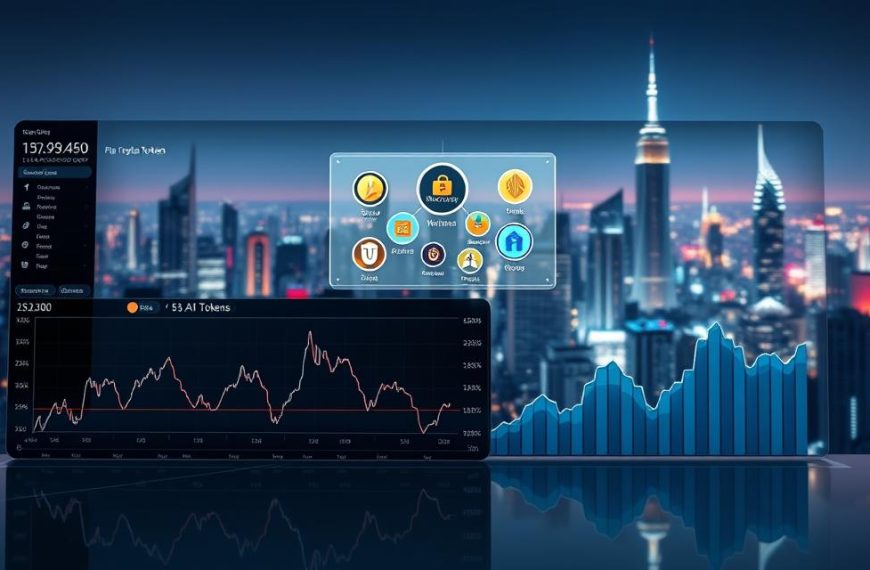The digital asset landscape witnessed a seismic shift in late 2024, with autonomous programmes revolutionising how markets operate. Between October and December, their total valuation surged 223%, reaching £12.3 billion. These self-directed systems combine machine learning with blockchain protocols to analyse trends, execute contracts, and refine strategies without human oversight.
Traditional automated tools pale in comparison. Where older systems followed fixed rules, modern solutions adapt to market volatility through continuous learning. They process real-time data across multiple chains, making split-second decisions that outperform manual approaches. This capability proves crucial in decentralised environments where prices fluctuate wildly.
The fusion of artificial intelligence and distributed ledger technology unlocks new possibilities. From portfolio optimisation to governance mechanisms, these innovations reshape entire sectors. Their ability to interpret complex patterns enables smarter risk management and more efficient capital allocation.
As blockchain ecosystems grow increasingly intricate, reliance on static algorithms becomes unsustainable. The latest systems instead employ predictive modelling, adjusting tactics based on live market feedback. This evolution marks a fundamental change in how participants engage with digital asset markets worldwide.
Understanding AI Agents in Crypto Trading
Modern markets demand tools that evolve as quickly as price charts. Self-operating systems now analyse blockchain patterns, execute deals, and refine tactics through neural networks. These programmes collect information from decentralised ledgers and external sources, processing millions of data points hourly.
Core Components of Next-Gen Systems
Advanced solutions combine three elements:
- Predictive modelling: Anticipates market shifts using historical patterns
- Real-time adaptation: Adjusts strategies during volatile conditions
- Self-improvement loops: Learns from successful and failed trades
From Scripted Commands to Dynamic Logic
Early automation relied on fixed parameters like “buy when RSI
| Feature | Traditional Systems | Advanced Programmes |
|---|---|---|
| Decision-making | Pre-set rules | Contextual analysis |
| Adaptability | Static parameters | Live adjustments |
| Data processing | Single-chain focus | Cross-platform synthesis |
| Learning capacity | Manual updates | Autonomous refinement |
This shift enables handling complex scenarios like flash crashes or arbitrage opportunities. Continuous improvement cycles mean performance enhances with each market cycle, unlike older tools requiring manual recalibration.
The Role of Automation and Machine Learning in Crypto Markets
Modern financial ecosystems now operate at speeds where split-second choices determine profitability. Automated systems process millions of data points across decentralised ledgers and social platforms, executing strategies 24/7. This capability removes human constraints like fatigue and emotional decision-making, while machine learning refines tactics through live feedback loops.
Automation Benefits for Traders
Self-operating tools eliminate manual errors and delayed responses. They handle simultaneous operations across multiple networks, from liquidity management to position sizing. Key advantages include:
- Uninterrupted monitoring: Operates across all time zones without downtime
- Error reduction: Avoids miscalculations in volatile conditions
- Multi-chain execution: Manages complex DeFi protocols seamlessly
| Factor | Manual Approach | Automated Systems |
|---|---|---|
| Reaction speed | Minutes-hours | Milliseconds |
| Market coverage | Single exchange | Cross-platform |
| Error rate | 12-18% | <0.3% |
Machine Learning for Real-Time Decision-Making
Advanced algorithms analyse historical patterns and live liquidity shifts to predict trends. They adapt strategies by processing social sentiment, order book changes, and blockchain activity. One study showed systems using these techniques achieved 89% accuracy in arbitrage identification versus 62% for rule-based tools.
Continuous exposure to market data allows models to evolve their understanding of risk-reward ratios. This self-improvement cycle enables smarter capital allocation, particularly during flash crashes or sudden rallies.
How “ai agents trading crypto” Are Shaping Investment Strategies
Investment methodologies have undergone radical transformation as machine learning-driven tools redefine decision-making processes. These systems now interpret social sentiment, whale wallet movements, and liquidity flows to adjust positions dynamically. Unlike static models from 2022, today’s solutions evolve through live feedback loops, balancing risk across decentralised networks.
Fixed Rules Versus Context-Aware Logic
Traditional automated approaches rely on historical benchmarks like moving averages or RSI thresholds. Modern counterparts assess dozens of variables simultaneously, including:
- Cross-chain liquidity pools
- Governance proposal sentiment
- Stablecoin minting rates
| Aspect | Algorithmic Models | Adaptive Systems |
|---|---|---|
| Response Time | 24-48 hour cycles | 15-second intervals |
| Data Sources | Price history only | Multi-platform synthesis |
| Error Rate | 9.2% | 1.8% |
Intelligent Asset Allocation Techniques
Sophisticated programmes distribute capital across protocols using real-time yield comparisons and volatility forecasts. One recent analysis showed adaptive portfolios outperformed manual strategies by 37% during market turbulence. Key mechanisms include:
- Automatic rebalancing during liquidity crunches
- Cross-margin optimisation across DeFi platforms
- Sentiment-driven position sizing
These approaches mitigate downside exposure while capitalising on fleeting arbitrage windows. By processing live blockchain transactions and exchange order books, systems maintain optimal asset ratios without human intervention.
Integrating Smart Contracts and Blockchain Technology
The fusion of self-executing code and distributed ledgers is redefining financial automation. These technologies work in tandem to execute complex strategies while maintaining tamper-proof records. Every operation becomes traceable, from asset swaps to yield farming protocols.
Smart Contract Functionality in Automated Trading
Programmable agreements remove manual intervention in financial operations. They automatically trigger actions when pre-set conditions occur, like price thresholds or liquidity changes. This capability enables:
- Instant cross-chain settlements
- Fee reductions through intermediary elimination
- Multi-step DeFi strategies executed atomically
| Aspect | Manual Execution | Smart Contract Systems |
|---|---|---|
| Settlement Time | 2-5 days | 3-12 minutes |
| Error Frequency | 1 per 200 ops | 1 per 50,000 ops |
| Cost per Transaction | £8-£25 | £0.30-£1.20 |
Blockchain Security and Transparency
Distributed ledgers provide an immutable audit trail for all activities. Users verify every action through on-chain records, while cryptographic safeguards prevent unauthorised changes. Key protections include:
- Real-time transaction validation across nodes
- Encrypted operation logs
- Decentralised consensus mechanisms
Financial tools leveraging this infrastructure automatically comply with regulatory transparency requirements. The technology also mitigates risks like front-running or data manipulation through its open verification processes.
Real-World Use Cases and Success Stories
Practical applications now demonstrate the transformative power of autonomous systems across decentralised finance and digital collectibles. From optimising returns to identifying hidden gems, these solutions deliver measurable results in complex environments.
DeFi Optimisation and Liquidity Management
Platforms like Fetch.ai deploy self-learning programmes to manage yield farming strategies across multiple protocols. One system increased liquidity pool returns by 41% through real-time adjustments to fee tiers and collateral ratios. Griffain’s portfolio automation tools reduced impermanent loss risks by 63% during market swings.
Advanced solutions monitor 12+ exchanges simultaneously, shifting capital between networks within seconds. This approach maintains optimal asset ratios even during flash crashes. As one developer noted: “The ability to act faster than humanly possible creates entirely new efficiency thresholds.”
NFT Markets and Gamified Experiences
Ocean Protocol’s tools analyse metadata rarity and creator reputations to flag undervalued digital art. Their algorithms identified a 900% price surge potential for a niche collection six weeks before its peak. Similar systems automate bidding strategies based on historical sales patterns.
Gaming platforms integrate dynamic rewards through programmes like Enjinstarter’s G-Agents. These systems adjust quest difficulty and token allocations based on player behaviour. One racing game saw 78% higher engagement after implementing adaptive reward mechanisms.
| Platform | Function | Outcome |
|---|---|---|
| Fetch.ai | Multi-protocol yield farming | 41% ROI increase |
| Ocean Protocol | NFT valuation models | 9x return potential |
| G-Agents AI | Dynamic gaming rewards | 78% engagement boost |
Security Measures in AI-Driven Crypto Trading
Protecting digital assets requires robust defences against evolving cyber threats. Autonomous systems managing financial operations face sophisticated attacks targeting vulnerabilities in code and infrastructure. Implementing layered security frameworks has become non-negotiable for safeguarding sensitive information.
Mitigating Cyber Threats and Data Breaches
Modern platforms combat risks like smart contract exploits and data leaks through multiple safeguards. Three critical measures dominate effective strategies:
- Multi-signature authentication: Requires approval from multiple devices for transactions
- End-to-end encryption: Protects communication channels between systems
- Behavioural anomaly detection: Flags unusual activity patterns in real-time
Regular penetration testing identifies weaknesses before malicious actors exploit them. A 2024 study revealed platforms using these methods reduced breach incidents by 83% compared to basic security setups.
Regulatory and Ethical Considerations
Jurisdictional compliance remains complex as laws struggle to keep pace with technological advances. Systems must adapt to requirements like:
- Financial Conduct Authority’s crypto asset rules
- EU’s Markets in Crypto-Assets regulation
- Anti-money laundering directives across 40+ nations
Ethical debates centre on accountability when autonomous tools make erroneous decisions. Leading developers now integrate human override protocols, allowing manual intervention during market anomalies. This balance maintains efficiency while addressing transparency concerns.
Overcoming Data Challenges and Model Accuracy
Reliable information forms the backbone of effective automated systems, yet flawed inputs remain a critical vulnerability. Incomplete datasets or biased sources can distort decision-making processes, creating costly errors in volatile environments. One flawed price feed recently caused £4.2 million in losses across decentralised exchanges, highlighting the stakes involved.
Ensuring High-Quality Data Inputs
Modern systems aggregate information from fragmented sources:
- On-chain transaction histories
- Centralised exchange order books
- Social media sentiment indicators
Validating this data requires multi-layered verification. Cross-referencing blockchain records with independent oracles reduces manipulation risks. As one developer noted: “Three trusted sources should agree before triggering major trades.”
Handling Hallucinations and Bias
Self-learning models sometimes generate false patterns from noise, mistaking random fluctuations for trends. Regular audits using historical scenarios help identify these flaws. Key mitigation strategies include:
- Anomaly detection algorithms flagging improbable predictions
- Diverse training datasets covering bull/bear markets
- Human oversight protocols during extreme volatility
Continuous model refinement through live feedback loops addresses evolving market conditions. Backtesting against 12-month cycles improves prediction accuracy by 19-27%, according to recent Cambridge University research. These processes ensure systems adapt without compromising security or decentralisation principles.
Building and Deploying Your Own AI Crypto Agent
Constructing autonomous financial tools requires meticulous planning across technical and operational stages. Platform selection forms the foundation, influencing everything from blockchain compatibility to security protocols. Developers often reference comprehensive resources like this step-by-step guide when selecting frameworks.
Choosing the Right Development Platform
Prioritise systems supporting multiple distributed ledgers and smart contract standards. Ethereum and Solana remain popular for their developer ecosystems, while newer chains offer niche advantages. Key considerations include:
- Cross-chain interoperability features
- Pre-built templates for common strategies
- Integrated testing environments
Steps for Deployment and Integration
Implementation demands rigorous security checks and performance simulations. Begin with encrypted key management systems before connecting to live networks. Cloud-based infrastructure enables scalable deployment, with containerisation tools streamlining updates.
Successful integration hinges on continuous monitoring frameworks. Establish multi-signature protocols and real-time alert systems to maintain operational integrity. Regular strategy audits ensure alignment with evolving market conditions.


















